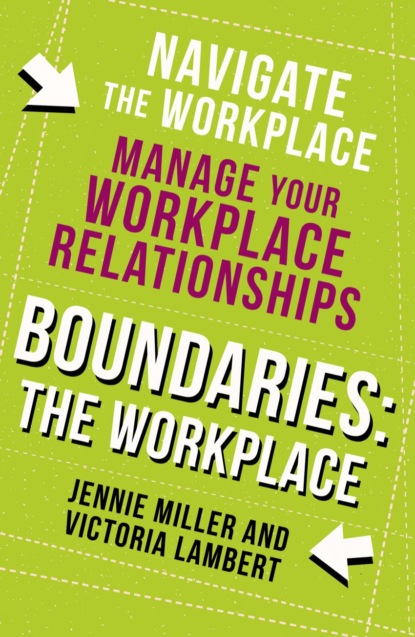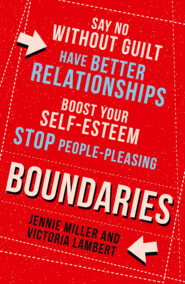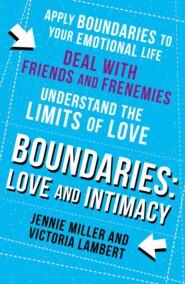По всем вопросам обращайтесь на: info@litportal.ru
(©) 2003-2024.
✖
Boundaries: Step Two: The Workplace
Настройки чтения
Размер шрифта
Высота строк
Поля
For example, our fast-paced lives require us to make more decisions than in the past, often quickly – yet with potentially serious consequences. The challenges to our boundaries are more complex and demanding, and we all need new strategies on how to live life as healthily as possible.
The effect of technology on our boundaries is particularly important when it comes to conversations and relationships. These used to be straightforward but now are more difficult because of the lack of face-to-face contact. Situations can easily be misread, moods can be misinterpreted and remarks can be misconstrued when you remove the physical presence of human contact.
The 24/7 culture of e-mails and the Internet means we can never switch off. We are no longer able to pull up the mental drawbridge – we are always vulnerable to what feels like outside pressures and invasions. Some of this attention is not unwelcome, we encourage it ourselves. But that doesn’t mean our boundaries are healthy; it may mean we don’t recognise what can hurt us.
The inspiration for this book came about through a conversation we shared on the subject of e-mail communication. In a steamy coffee shop full of post-school run parents and busy workers grabbing a latte to go, we found ourselves catching up on life, work, family and friends. During our chat, Victoria mentioned a familiar dilemma she was struggling with – she had been asked to help with a function which she had neither the time, energy, or the desire to do. However, she felt a strong pull to be useful and the resulting emotion was guilt. Jennie identified her problem as being a lack of boundaries and explained the concepts that underpin them (as we will explore in this book).
Victoria went home inspired and wrote an e-mail explaining to a colleague why she couldn’t help at the function. She wrote:
‘I am so sorry to say that I feel I cannot help with your plans towards putting on this event. I am really busy with work and childcare at the moment, so am finding it hard to make time. Obviously, I will still do what I can to be useful, and don’t forget to ask me to invite those people we mentioned, but I think that will have to be my input for now. Do call if I can do anything else.’
Then she thought again about Jennie’s explanation of boundaries, and realised she wasn’t being honest. Moreover, she was soft-soaping her decision because she felt guilty – which was confusing the issue, not clarifying it. Several long phone calls with Jennie followed as Victoria was feeling uncomfortable and anxious about the potential response. Jennie encouraged her to be brave and brief.
This was her second draft (with self-boundary): ‘I won’t be available to help with your event. I know it will be a huge success, and wish you well.’
And the response to that second e-mail: ‘Fair enough. Thank you for letting me know. Do come if you can.’
What Victoria found was that waiting for a response to a boundaried e-mail can feel nail-biting. However, as can be seen from the reply, others usually respond surprisingly well to a clear and no-nonsense message.
Think back to the last time you received a clear, concise e-mail. Wasn’t it refreshing and easier to engage with?
You need to know that your boundaries are in your control. You have the ability to decide when and how to draw the line in your life. This will be one of the most empowering lessons you ever learn.
How to Picture a Boundary
Depending on your personality and outlook, you may think of a boundary as an encircling brick wall or perhaps a fresh-looking picket fence with a gate always propped open, but we’d like to invite you to also think of your personal boundary in quite a different way.
Consider human skin. It’s dense enough to protect and contain us, but flexible enough to allow for movement. Skin is porous in the upper layers so what’s necessary can pass through – sweat can be excreted and sunshine absorbed to help us make vitamin D. Skin is also sufficiently tough to withstand accidental damage, and it’s capable of amazing re-growth.
As with skin, we can feel discomfort – even temporary pain at times – when boundaries get damaged either internally or from the outside when we don’t take care. Yet, again like our skin, boundaries are amazing because they can grow with us.
Why have we chosen to use skin as a metaphor? Because skin keeps us in contact with others – it’s not a brick wall or other type of opaque barrier. Studies show that skin-to-skin contact is actually vital for humans. Think of the studies which have shown that ‘kangaroo care’ – the nestling of a naked newborn on its parents’ bare chests – improves outcomes in premature baby care. And equally our skin can act as an early warning system for our entire bodies. Think of how your skin prickles when another person gets too close – it’s a very physical sensation.
Now, let’s look at your own personal boundaries.
EXERCISE: Your Personal Boundary
You will need another person to do this exercise with you. This other should be a friend or colleague but not someone with whom you are very close. We understand this may not feel easy, and you would be more comfortable with someone more familiar to you. But in close relationships, boundaries will be well established. We need you to step outside your comfort zone in order to experience a fresh boundary.
Begin by standing facing each other a comfortable distance apart – this might be four foot away from each other, or more or less.
You are going to stay on your spot. Notice the distance that feels comfortable. Now ask your exercise partner to step closer. They are now in charge of their movements and are gradually going to take one step at a time towards you, pausing for 30 seconds between each step. In that pause, consider how comfortable you feel.
As they come closer, note when you start to feel some level of discomfort. And when do you notice you are really not happy, and that your skin is starting to throw up a few goosebumps? When do you want to scream ‘stop’ – because your personal space now feels properly invaded? At that point ask your partner to step back.
So, what just happened?
This is your body unconsciously registering where it feels most comfortable in relation to another person. This is your discernible physical boundary. Bear this in mind as you read through the book – who oversteps this boundary and who stays too far away?
We suggest you have a notebook to hand while you go through the book so you can write down your experience of exercises like this and ideas that you want to make a note of so you can build up your own Learning Journal as you work through the book.
Part of understanding how to use boundaries is learning to look at interpersonal relationships and your own part in them. Then, deciding where and how to establish a boundary doesn’t just get easier, it becomes self-evident. The exercise above is your first step towards this.
Developing confidence in your own decision-making and its effect on your behaviour will make you happier as it means you are properly owning and taking care of yourself. In our experience: boundaries can give peace of mind. Boundaries give freedom. Boundaries are bliss.
STEP TWO: THE WORKPLACE
‘I put my heart and soul into my work, and lost my mind in the process.’
VINCENT VAN GOGH
We’ve all heard of the concept of work-life balance, but how many of us practice it? It’s too easy to work just a little longer to impress the boss, on the one hand; or to take an extra 20 minutes in the pub at lunchtime when you no longer care to impress anyone – on the other.
Thanks to technology, work has become even more consuming than it ever was. The reality of modern life also interferes with the best-laid plans – as our mobile devices have become ubiquitous, intrusive and often can seem impossible to escape. Would van Gogh have created so many of his 2,000-odd paintings, sketches and drawings had he also been checking his FB page several times each day? It’s a sobering thought.
So, establishing boundaries around your work will help you achieve balance on a practical level, improving your relations with colleagues and the boss, supporting you through workplace issues like bullying and romantic entanglements and making work life more pleasant overall. This section of the book applies regardless of whether you are employer, employee, freelancer, consultant, charity worker, stay-at-home mum (it’s definitely a full-time job), or intern. We’ll still be asking you to complete exercises – remember, there are no right or wrong answers – and keep adding notes to build your Learning Journal.
We talked about social media in Step One: Me, Myself and I (http://ads.harpercollins.com/bobauk?isbn=9780008324681), and we’ve built on that with advice concerning all forms of mobile distraction, engagement and temptation. But we’re also interested in exploring those other intangible boundaries that dictate how we relate to our colleagues, bosses and employees, as these relationships are some of the most intense and therefore time-consuming that we have during our lives.
For example, it can be easy to believe that work relationships are crucial to our happiness – how often do you hear people refer to my ‘work husband’ or ‘work wife’? Indeed, a 2006 survey quoted by CNN Money found that 32 per cent of office workers said they have an office ‘spouse,’ with many having more than one. But that perceived importance is not necessarily based in reality. Their value often lies more in how they affect our outside relationships and the way we treat ourselves.
In the UK, we typically spend 40.8 hours a week at work, compared to a European average of 38.1 hours according to the European Foundation for the Improvement of Living and Working Conditions. If this time is full of tension and conflict on an interpersonal level, let alone tiring and stressful physically, we’re setting ourselves up for misery.
Employment Tribes (#ulink_2f6b6018-c86a-5eae-910e-10b0118ddc51)
Learning to understand your colleagues and improve your work relationships is a vital first step towards improving your working life. We’ve identified five key workplace roles to help you to understand how often boundaries are breached and broken all day every day, and to teach you how to deal with different types of colleagues as well as your own behaviour.
As you read through the characters, note down in your Learning Journal where you recognise yourself or someone you know from your workplace. Be aware – workers may well fit into one or more set of characteristics; indeed you may move from one set to another yourself.
The A-Lister
Always anxious about their health, the ‘A-Lister’ (where A stands for Ailment) is either off work with ‘another virus’ regularly, or can be seen seeking sympathy in the office by bringing symptoms into the workplace or constantly discussing them. Not necessarily hypochondriac, the A-Lister’s concerns may be quite real.
This behaviour is essentially Child-like and pushes others’ self-boundaries by demanding sympathy, attention and perhaps support with the workload or a difficult boss.
Think of the Drama Triangle – this character is in the Victim position, wanting to be Rescued, but of course also inviting Persecution. Reactions can range from ‘Poor you’ (Rescuer) to ‘Not again’ (Persecutor).
BRING IN THE BOUNDARIES:
Your A-Lister Plan
If this is you …
Ask yourself a few questions:
• Can you remember when you first started to feel constantly unwell – that sense of picking up every bug going around?
• Does this chime with starting your current job or a recent career move?









